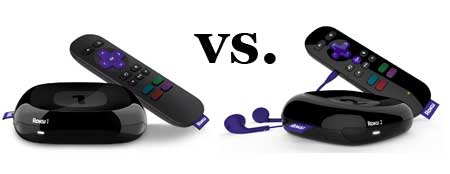It can be difficult to choose between Roku models, but especially so when you are contemplating the Roku 1 vs the Roku 2. Both models have connection options for both HD and standard definition televisions, can play 720 and 1080p content, and can use the one-stop search feature. You can see a complete comparison of their features in the chart below. But if you need help determining what makes these two devices different, and whether those differences are worth the added cost, then continue reading the article below. As you can see from the chart above, these two Roku models are very similar to one another, aside from a few minor features that the Roku 2 has that are not present on the Roku 1. The Roku 1 is also significantly cheaper than the Roku 2, which places a specific value on the additional features that you get with the Roku 2.
Some Roku 1 Advantages
One important thing to consider when you are choosing between the Roku 1 and the Roku 2 is that the channels will behave exactly the same on both models, and both models perform at a very similar level. So there won’t be any significant performance differences between the Roku 1 and the Roku 2, aside from issues related to wireless signal strength. But since these models are nearly identical, and there are no features on the Roku 1 that are not on the Roku 2, then the biggest advantage of the Roku 1 is its’ price. And while the $20 dollar difference at MSRP may not initially seem like a significant savings, you do need to consider the fact that you are talking about a product that only costs about $60. So that $20 price increase is actually a 33% percent relative increase in cost for some features that many people might not even use and, depending upon where your Roku is positioned relative to your wireless router, are features that you may not even notice.
Some Roku 2 Advantages
While we mentioned in the Roku 1 advantages section that there are only a couple of minor differences between these models, they can be the deciding factor for people that are going to use them. The biggest advantage of the Roku 2 over the Roku 1 is the dual band Wi-Fi. This is going to improve the wireless range of the device and provide you with a much stronger wireless signal on the Roku 2. So if you are placing your Roku 2 in a location that is relatively far from your wireless router, such as on a different floor or through a number of walls, then you will have a better signal with the Roku 2 than the Roku 1. And for a device whose primary purpose relies upon the strength of that wireless signal, this can be an important factor. The other significant difference between the Roku 1 and the Roku 2 is the headphone jack on the remote control. This is a really cool feature, especially if you are placing the Roku in a bedroom where one person likes to listen to the TV, while the other person likes silence. Simply plug the headphones into the remote control jack and the TV will mute and the sound will be output through the headphones. This is an awesome feature for people that have a use for it, and it works remarkably well.
Conclusion
The Roku 1 and the Roku 2 are very similar and, aside from the two main differences highlighted above, could easily be mistaken for the same device. They look similar, the remotes have similar functions, and they perform comparably. For the majority of users the Roku 1 will be the best option, simply because of the lower cost. But the correct choice between these two models is going to depend entirely upon your personal situation. If you aren’t concerned about the strength of your wireless signal and you don’t think you will use the headphone remote option, then the Roku 1 is the clear choice. But if you have trouble with wireless signal strength on other devices near where you will be installing your Roku, or if you envision yourself using the headphone remote option, then the added cost for these features is worth upgrading to the Roku 2. After receiving his Bachelor’s and Master’s degrees in Computer Science he spent several years working in IT management for small businesses. However, he now works full time writing content online and creating websites. His main writing topics include iPhones, Microsoft Office, Google Apps, Android, and Photoshop, but he has also written about many other tech topics as well. Read his full bio here.























